Photo Courtesy of the Border Heritage Center at the Main Library. It is from the 1924 El Paso County School Annual.
The first public school opened in 1905, in a one-room building on the Henry Elm Farm. The first public school teacher was John Phelan who taught 12 students. In 1905 the building burned down, but in 1909 Charles Newman donated the first block of land for a new school. The school was completed on December 1, 1909. 15 children were taught in one large room. This building was also used by the Fabens Methodist Church, a Minster would hold services there once a month. The first school trustees; Jesus Cobos, C.F. White, and Pat O’Donnell help established the first public school. In 1913 Josephine Silva Daltons taught 80 students, these children’s parents were refugees from the Mexican Revolution. That school building was sold to J.M. Escajeda. The first school building was on the 300 block of Main.
Hispanic and Anglo kids were educated separately. Anglos were taught in a tent on the corner of Fabens and Camp. Jesus Cobos, a member of the Fabens School board, donated money to build a new school that would later be named after him and then became the Latin American School in 1925. A new school for Anglos was built in 1927. Cobos school was used as a hospital in 1918. The first high school was in the Bungalow courts. Cobos was torn down to make way for a new high school building in 1948. The school was built in the 1920s became an immediate school, African Americans and Hispanic children were educated in the Camp building. The school was built in the 1920s is still up but is no longer used for a school. Tornillo was also part of the Fabens school district until 1923.
A school was opened at La Isla, near Fabens in 1914 by John Phelan and Ashley Gillett in the home of the Sierra Family in La Isla. It was its own school district until it was consolidated with Fabens in 1924. The building was used as the Latin American school until 1928. In 1927 a new school was built but only Hispanics kids who could speak English were allowed. Non-English speakers would stay at the Cobos School until it was demolished. In 1950 the new high school opened. During the Depression years from 1936 to 1961, a county school for African Americans was established. In 1953 a new primary school was built it was named after County Commissioner and educator, Troy M. Risinger, and it was renamed David Sublosky Head Start Early Childhood Center. In 1963 Johanna O’Donnell Elementary opened housing 4th and 5th grades. It moved to the old high school when a new high school was built in 1988 on G Avenue NE.
In 1929 Fabens became an Independent School District with M.D. Lakey as Superintendent of Schools. Members of the board were; J.L. Carr, E.L. Wilson, C.J. Peck, T.L Bell, Fred Griffin, E.L. Wilson, John Marchbanks, and O.P. Ford. Fabens came about because of the fact, that the railroads ran through it.
Fabens was named for Assistant Land Commissioner for the Southern Pacific Lines in Texas and Louisiana. The Fabens Townsite was laid out in 1913. It was part of the San Elizario Grant and it was sold to the E.S. Newman in 1881. Fabens was briefly a city, its first mayor was John Marchbanks, it incorporated in 1929, but the resident decided to disincorporate in 1931. C.M. Buchanan was the last and second mayor of Fabens,
EPHS Curator,
Joseph Longo

